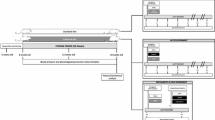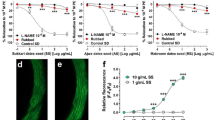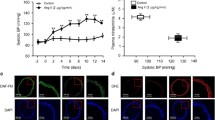Abstract
Grape seed extract contains high concentration of polyphenols that are well known as potent vasodilators. Herein, we investigated the blood pressure-lowering effect of enzyme-treated grape seed extract (ET-GSE) and the involvement of endothelium nitric oxide synthase (eNOS), which plays an important role in the regulation of vasodilation and relaxation of blood vessels in male spontaneously hypertensive rats (SHRs). Six-week-old male Wistar Kyoto rats and SHRs were orally administered ET-GSE (15 and 30 mg/kg/day) as treatments for 8 weeks. Systolic blood pressure (SBP) and diastolic blood pressure (DBP) were measured by the tail-cuff method. After treatment for 8 weeks, thoracic aortas of sacrificed rats were harvested for detecting eNOS by Western blot analysis. SHRs treated with ET-GSE exhibited significantly lower SBP and DBP as well as higher expression of eNOS compared with control animals (p<0.05). These findings suggest that ET-GSE can contribute to regulate blood pressure through up-regulated eNOS expression for nitric oxide production.
Similar content being viewed by others
References
Husserl FE, Messerli FH. Adverse effects of antihypertensive drugs. Drugs 22: 188–210 (1981)
Joshi VD, Dahake AP, Suthar AP. Adverse effects associated with the use of antihypertensive drugs: An overview. Int. J. PharmTech Res. 2: 10–13 (2010)
Sivaprakasapillai B, Edirisinghe I, Randolph J, Steinberg F, Kappagoda T. Effect of grape seed extract on blood pressure in subjects with the metabolic syndrome. Metabolism 58: 1743–1746 (2009)
Barona J, Aristizabal JC, Blesso CN, Volek JS, Fernandez ML. Grape polyphenols reduce blood pressure and increase flow-mediated vasodilation in men with metabolic syndrome. J. Nutr. 142: 1626–1632 (2012)
Belcaro G, Ledda A, Hu S, Cesarone MR, Feragalli B, Dugall M. Grape seed procyanidins in pre-and mild hypertension: A registry study. Evid-Based Compl. Alt. Article ID 313142 (2013)
Ou K, Gu L. Absorption and metabolism of proanthocyanidins. J. Funct. Foods 7: 43–53 (2014)
Thandapilly SJ, LeMaistre JL, Louis XL, Anderson CM, Netticadan T, Anderson HD. Vascular and cardiac effects of grape powder in the spontaneously hypertensive rat. Am. J. Hypertens. 25: 1070–1076 (2012)
Quiñones M, Guerrero L, Suarez M, Pons Z, Aleixandre A, Arola L, Muguerza B. Low-molecular procyanidin rich grape seed extract exerts antihypertensive effect in males spontaneously hypertensive rats. Food Res. Int. 51: 587–595 (2013)
Pons Z, Guerrero L, Margalef M, Arola L, Arola-Arnal A, Muguerza B. Effect of low molecular grape seed proanthocyanidins on blood pressure and lipid homeostasis in cafeteria diet-fed rats. J. Physiol. Biochem. 70: 629–637 (2014)
Quiñones M, Guerrero L, Fernández-Vallinas S, Pons Z, Arola L, Aleixandre A, Muguerza B. Involvement of nitric oxide and prostacyclin in the antihypertensive effect of low-molecular-weight procyanidin rich grape seed extract in male spontaneously hypertensive rats. J. Funct. Foods 6: 419–427 (2014)
FDA. Guidance for industry: Estimating the maximum safe starting dose in initial clinical trials for therapeutics in adult healthy volunteers. Food and Drug Administration, Rockville, MD, USA (2005)
Scalbert A, Morand C, Manach C, Rémésy, C. Absorption and metabolism of polyphenols in the gut and impact on health. Biomed. Pharmacother. 56: 276–282 (2002)
Déprez S, Mila I, Huneau J-F, Tomé D, Scalbert A. Transport of proanthocyanidin dimer, trimer, and polymer across monolayers of human intestinal epithelial Caco-2 cells. Antioxid. Redox Sign. 3: 957–967 (2001)
Holt RR, Lazarus SA, Sullards MC, Zhu QY, Schramm DD, Hammerstone JF, Fraga CG, Schmitz HH, Keen CL. Procyanidin dimer B2 [epicatechin-(4²-8)-epicatechin] in human plasma after the consumption of a flavanol-rich cocoa. Am. J. Clin. Nutr. 76: 798–804 (2002)
Tsang C, Auger C, Mullen W, Bornet A, Rouanet JM, Crozier A, Teissedre PL. The absorption, metabolism and excretion of flavan-3-ols and procyanidins following the ingestion of a grape seed extract by rats. Brit. J. Nutr. 94: 170–181 (2005)
Shrikhande AJ, Wang H, Kupina SA. Grape extract, dietary supplement thereof, and processes therefor. US Patent No. 8,075,929 B2 (2011)
Robinson M, Lu B, Edirisinghe I, Kappagoda CT. Effect of grape seed extract on blood pressure in subjects with pre-hypertension. J. Pharm. Nutr. Sci. 2: 155–159 (2012)
Edirisinghe I, Burton-Freeman B, Kappagoda CT. Mechanism of the endothelium-dependent relaxation evoked by a grape seed extract. Clin. Sci. 114: 331–337 (2008)
Singleton VL, Rossi JA,. Colorimetry of total phenolics with phosphomolybdicphosphotungstic acid reagents. Am. J. Enol. Viticult. 16: 144–158 (1965)
Moyer RA, Hummer KE, Finn CE, Frei B, Wrolstad RE. Anthocyanins, phenolics, and antioxidant capacity in diverse small fruits: Vaccinium, Rubus, and Ribes. J. Agr. Food Chem. 50: 519–525 (2002)
García-Falcón MS, Pérez-Lamela C, Martínez-Carballo E, Simal-Gándara J. Determination of phenolic compounds in wines: Influence of bottle storage of young red wines on their evolution. Food Chem. 105: 248–259 (2007)
Šeruga M, Novak I, Jakobek L. Determination of polyphenols content and antioxidant activity of some red wines by differential pulse voltammetry, HPLC and spectrophotometric methods. Food Chem. 124: 1208–1216 (2011)
Kim SH, Lee TH, Lee SM, Park JH, Park KH, Jung M, Jung H, Mohamed MAA, Baek NI, Chung IS, Kim JY. Cynandione A attenuates lipopolysaccharideinduced production of inflammatory mediators via MAPK inhibition and NF-κB inactivation in RAW 264.7 macrophages and protects mice against endotoxin shock. Exp. Biol. Med. 240: 946–954 (2015)
Kruger MJ, Davies N, Myburgh KH, Lecour S. Proanthocyanidins, anthocyanins and cardiovascular diseases. Food Res. Int. 59:41–52 (2014)
Mattivi F, Vrhovsek U, Masuero D, Trainotti D. Differences in the amount and structure of extractable skin and seed tannins amongst red grape varieties. Aust. J. Grape Wine R. 15: 27–35 (2009)
Banaszewski K, Edirisinghe I, Kappagoda T, Burton-Freeman B, Zweigenbaum J, Cappozzo J. Detection and characterization of polyphenolic compounds and their metabolites in human plasma after consumption of grape seed extract (abstract no. 2221). In: Abstracts: 60th ASMS Conference. May 20-24, Vancouver Convention and Exhibition Centre, Vancouver, Canada. American Society for Mass Spectrometry, Santa Fe, NM, USA (2012)
Luo Y, Owens D, Mulder G, McVey A, Fisher T. Blood pressure characterization of hypertensive and control rats for cardiovascular studies. In: Abstracts: 62nd High Blood Pressure Research Conference. September 17-20, Omni Hotel at CNN Center, Atlanta, GA, USA. American Heart Association, Dallas, TX, USA (2008)
Cishek MB, Galloway MT, Karim M, German JB, Kappagoda CT. Effect of red wine on endothelium-dependent relaxation in rabbits. Clin. Sci. 93: 507–511 (1997)
Bauer V, Sotníková R. Nitric oxide-The endothelium-derived relaxing factor and its role in endothelial functions. Gen. Physiol. Biophys. 29: 319–340 (2010)
Lockette W, Otsuka Y, Carretero O. The loss of endothelium-dependent vascular relaxation in hypertension. Hypertension 8(suppl II): II-61-II-66 (1986)
Malinski T, Kapturczak M, Dayharsh J, Bohr D. Nitric oxide synthase activity in genetic hypertension. Biochem. Bioph. Res. Co. 194: 654–658 (1993)
Stoclet J-C, Chataigneau T, Ndiaye M, Oak M-H, El Bedoui J, Chataigneau M, Schini-Kerth VB. Vascular protection by dietary polyphenols. Eur. J. Pharmacol. 500: 299–313 (2004)
Author information
Authors and Affiliations
Corresponding author
Rights and permissions
About this article
Cite this article
Jang, HH., Park, S.K., Choi, GY. et al. Anti-hypertensive effect of grape seed extract in male spontaneously hypertensive rats. Food Sci Biotechnol 24, 2229–2233 (2015). https://doi.org/10.1007/s10068-015-0297-3
Received:
Revised:
Accepted:
Published:
Issue Date:
DOI: https://doi.org/10.1007/s10068-015-0297-3




